by Patrick Roefflaer
This article is part of a series reviewing the artwork across Dylan’s albums. There is an index to past articles below, and at the top of the page under “Album Artwork”
Episode 33 – “Love and Theft”
- Released: 2001-09-11
- Photographers Kevin Mazur, David Gahr, Danny Clinch
- Art-director Geoff Gans
For the cover art of Dylan’s 31st studio album “Love and Theft”, no less than three photographers were employed, and three different shoots were undertaken.
Kevin Mazur
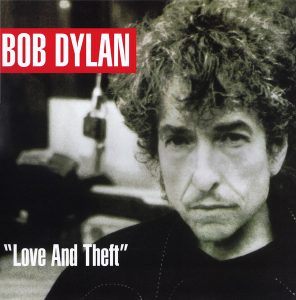 On the front, the singer looks determinedly into the lens and proudly shows his new look with the pencil-thin moustache.
On the front, the singer looks determinedly into the lens and proudly shows his new look with the pencil-thin moustache.
The black and white portrait was made by the concert photographer of the new millennium: New Yorker Kevin Mazur. The Rolling Stones, U2, Nirvana… they all want him to capture their appearance on stage.
As the official photographer for the likes of the MTV Video Music Awards and the Rock and Roll Hall of Fame’s annual induction ceremony, he had photographed Dylan before.
He captured the famous Soy Bomb incident at the 1998 Grammy Awards in New York City’s Radio City Music Hall on February 25th, 1998. And he was also present at an Academy Awards party in Los Angeles on March 20th, 1999, where he portrayed Dylan in the company of Madonna and Chris Rock.
In 2018 the photographer explained that the photo was the result of an organized accident: “I was there for the recording of Love and Theft with Bob Dylan [May 2001].
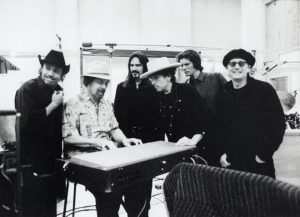 My photo ended up being the album cover. Bob at one point during the recording said to someone, ‘Hey man I think you should have Kevin come in and take photos.’ And I was hiding behind a road case. I popped out and I said, ‘I’m right here, Bob.’ He jumped. I scared the shit out of him.”
My photo ended up being the album cover. Bob at one point during the recording said to someone, ‘Hey man I think you should have Kevin come in and take photos.’ And I was hiding behind a road case. I popped out and I said, ‘I’m right here, Bob.’ He jumped. I scared the shit out of him.”
During the same occasion, he also made the group shot of the band, gathered around guest player Augie Meyers’ Hammond B-3 organ.
David Gahr
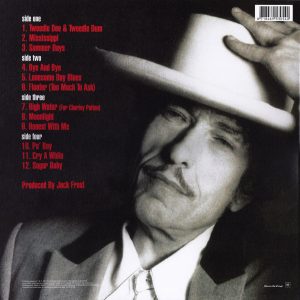 The photo on the back of the album breathes the same atmosphere as the one on the front. A smartly dressed Dylan – moustache still present – lifts his white hat to the viewer.
The photo on the back of the album breathes the same atmosphere as the one on the front. A smartly dressed Dylan – moustache still present – lifts his white hat to the viewer.
This portrait is made by an old acquaintance of the singer, going back to the start of his career in Greenwich Village, capturing him performing at Carnegie Hall (1962), and the festivals in Newport Folk (1963-’65) and once more in Winter 1971 in New York.
Gahr later made the album covers of Springsteen’s The Wild, the Innocent & the E Street Shuffle, and Clapton’s 461 Ocean Boulevard.
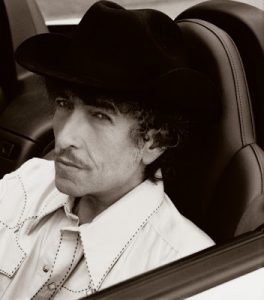 In the Summer of 2001, Dylan invited the then 79-year-old photographer to shoot him around the Brooklyn area of New York. They spent an afternoon in Prospect Park, Brighton Beach Boardwalk, Pitkin Avenue, and Coney Island.
In the Summer of 2001, Dylan invited the then 79-year-old photographer to shoot him around the Brooklyn area of New York. They spent an afternoon in Prospect Park, Brighton Beach Boardwalk, Pitkin Avenue, and Coney Island.
For the exact locations, you can look at Bob Egan’s wonderful Pop Spots site
One thing, though: It states that the pictures were made in November 2001, two months after the album was released.
In the booklet, two more photos from the shoot were used: the one with Dylan sitting in a sportscar, wearing a black hat, and another one where he stands in a pavilion on Brighton Beach boardwalk.
Danny Clinch
In the liner notes of the cd-booklet one more photographer is mentioned: Danny Clinch. In March of 1999, he was an up-and-coming photographer in Los Angeles, when he got a phone call from Dylan’s management, asking him to take some pictures of Bob Dylan.
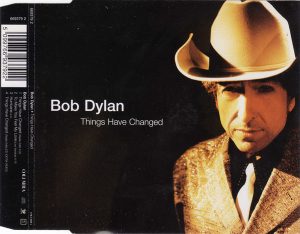 “It was kind of a dream come true”, Clinch said to Rolling Stone magazine in 2014. “I didn’t even think he’d show up, I just didn’t believe it. I was really prepared and I booked this place called the Ambassador Hotel in Los Angeles. That’s not only where the Rat Pack played all the time in the Coconut Grove room, but Robert Kennedy was assassinated in the kitchen there. It was really cool because there’s a lot of different styles and locations. I thought, ‘If I have Bob Dylan, I want to make the most of it.’
“It was kind of a dream come true”, Clinch said to Rolling Stone magazine in 2014. “I didn’t even think he’d show up, I just didn’t believe it. I was really prepared and I booked this place called the Ambassador Hotel in Los Angeles. That’s not only where the Rat Pack played all the time in the Coconut Grove room, but Robert Kennedy was assassinated in the kitchen there. It was really cool because there’s a lot of different styles and locations. I thought, ‘If I have Bob Dylan, I want to make the most of it.’
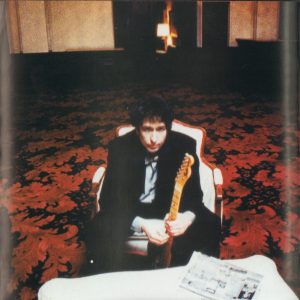 “Little did I realize, he’d be so enthralled by the fact that all that history had happened there. We wandered all around this hotel and got a history lesson from the guy that was our host. Dylan was completely into it, so he stuck around for a really long time.
“Little did I realize, he’d be so enthralled by the fact that all that history had happened there. We wandered all around this hotel and got a history lesson from the guy that was our host. Dylan was completely into it, so he stuck around for a really long time.
“He was intrigued by it”, Clich said to Andy Gensler, for another interview published in October 2010 in Culture. “He originally committed to four hours and I thought if I could just get two that would be great. He doesn’t do a lot of shoots, and ours ended up being seven hours.
“ He showed up and I had my camera on and we talked about what we wanted to do, and he seemed really excited about it. I picked my camera up right away and he was like, “I’m going to change my clothes.” He looked in a mirror and was fixing his hat and I just started shooting.
He showed up and I had my camera on and we talked about what we wanted to do, and he seemed really excited about it. I picked my camera up right away and he was like, “I’m going to change my clothes.” He looked in a mirror and was fixing his hat and I just started shooting.
“From that shoot, I had stuff in Love and Theft and some of the singles. Talk about an honor of placement for your photography, to have pictures in a Bob Dylan record.”
He refers to the color picture used only in the cd-booklet where Dylan, seated on a white couch, guitar in hand, looks straight into the camera. It’s an outtake of the classic shot of Dylan reading a newspaper with his feet up. “That was the shoot. [The Ambassador Hotel] has this cantina feel about it, and every room is different. There were these cabanas by the pool with old shutters and chipped paint — it was really cool.”
From the same shoot comes another famous picture, with Dylan wearing what looks like a golden suit and hat, holding a harmonica.
“On the way over to the shoot I get a call from his publicist”, Clinch says in 2014, “and he said, ‘Bob wants to know if you are familiar with Little Walter.’ I said, ‘Yeah, I’m a big fan of Little Walter. I play harmonica myself.’
He says, ‘There’s a famous photo of him on one of his records and he’s holding the harmonica and it’s Hollywood lighting.’ I said, ‘Yeah, I know exactly what you’re talking about. In fact, I have that CD here at the shoot.’ He was like, ‘Oh, great.’ They show up and Bob’s psyched that I knew what he was talking about. When I was waiting for them to arrive, I set up this old-school, Hollywood-style lighting. He pulls out this old chromatic harmonica, which was really beautiful. I then proceeded to shoot in that style.
“They’ve been using this photo on all the posters they have at all the Dylan shows. This photo has been reproduced, like, a million times. Since 1999, they’ve used others there and again, but this has been the staple and I’m super proud of that.“
Geoff Gans
Since 1996, Geoff Gans is the preferred art director for Dylan’s albums and box sets. He didn’t have too much work with this one: just adding the title and name of the artist in white letters, with an extra red rectangular highlighting the name.
For the back, the same color scheme is used for the song titles and the added info: Produced by Jack Frost.
The title is presented as a quote, presumably as a reference to the 1993 book by Eric Lott: Love & Theft: Blackface Minstrelsy and the American Working Class.
——————–
Here are the articles so far . All are by Patrick Roefflaer.
- Another side of Bob Dylan
- Biograph – see Empire Burlesque
- Blonde On Blonde: The Artwork
- Blood on the Tracks
- Bob Dylan
- Bob Dylan’s Greatest Hits
- Bringing it All Back Home
- Desire
- Down in the Groove
- Dylan
- Empire Burlesque and Biograph artwork
- Good as I’ve been to you
- Greatest Hits Volume II
- Highway 61 Revisited
- Infidels: what’s in a name?
- John Wesley Harding: the art work
- Knocked Out Loaded
- Nashville Skyline
- New Morning
- Oh Mercy
- Pat Garrett and Billy the Kid
- Self-Portrait
- Slow Train Coming
- Street Legal and the secret cover location
- The Basement Tapes
- The Freewheelin’ Bob Dylan – the untold story of the artwork of the album
- The Times they are a changin’ album artwork
- Time out of Mind
- Travelling Wilburys Vol 1 (guest visitor, Michael Palin)
- Triplicate
- World Gone Wrong


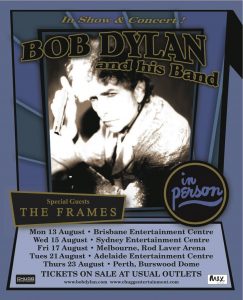
Interesting as always.
Mr. Garcia is playing a Vox organ in the picture posted.
The CD version I bought the day it came out has two pictures of Bob in a full-length leather coat. Am I the only one who got a hearty chuckle when I saw that? I immediately was brought back to the line from Highlands, the closing track on his previous album, where he sings” I think what I need might be a full-length leather coat…”
I was hoping it was intentional. It also made me think of “The next 60 seconds could be like an eternity”… In the sense that it is Bob playing around giving a wink to his own work.
The vinyl version I picked up a few years ago does not have those pictures.